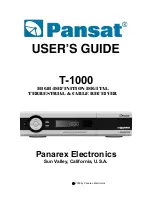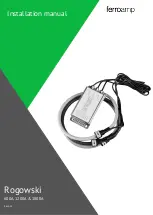
CC1000
SWRS048A Page 9 of 55
5. Circuit Description
Figure 1. Simplified block diagram of the
CC1000
A simplified block diagram of
CC1000
is
shown in Figure 1. Only signal pins are
shown.
In receive mode
CC1000
is configured as a
traditional superheterodyne receiver. The
RF input signal is amplified by the low-
noise amplifier (LNA) and converted down
to the intermediate frequency (IF) by the
mixer (MIXER). In the intermediate
frequency stage (IF STAGE) this
downconverted signal is amplified and
filtered before being fed to the
demodulator (DEMOD). As an option a
RSSI signal, or the IF signal after the
mixer is available at the RSSI/IF pin. After
demodulation
CC1000
outputs the digital
demodulated data on the pin DIO.
Synchronisation is done on-chip providing
data clock at DCLK.
In transmit mode the voltage controlled
oscillator (VCO) output signal is fed
directly to the power amplifier (PA). The
RF output is frequency shift keyed (FSK)
by the digital bit stream fed to the pin DIO.
The internal T/R switch circuitry makes the
antenna interface and matching very easy.
The frequency synthesiser generates the
local oscillator signal which is fed to the
MIXER in receive mode and to the PA in
transmit mode. The frequency synthesiser
consists of a crystal oscillator (XOSC),
phase detector (PD), charge pump
(CHARGE PUMP), VCO, and frequency
dividers (/R and /N). An external crystal
must be connected to XOSC, and only an
external inductor is required for the VCO.
The 3-wire digital serial interface
(CONTROL) is used for configuration.
PDATA, PCLK, PALE
LNA
PA
DEMOD
VCO
PD
OSC
~
/N
MIXER
CHARGE
PUMP
L1
RF_IN
DIO
CHP_OUT
IF STAGE
RF_OUT
RSSI/IF
3
CONTROL
XOSC_Q2
XOSC_Q1
/R
DCLK
L2
LPF
BIAS
R_BIAS
PDATA, PCLK, PALE
LNA
PA
DEMOD
VCO
PD
OSC
~
/N
MIXER
CHARGE
PUMP
L1
RF_IN
DIO
CHP_OUT
IF STAGE
RF_OUT
RSSI/IF
3
CONTROL
XOSC_Q2
XOSC_Q1
/R
DCLK
L2
LPF
BIAS
R_BIAS










































